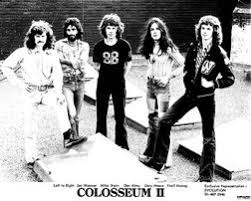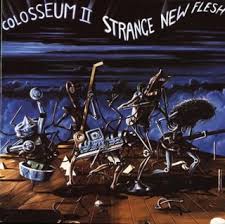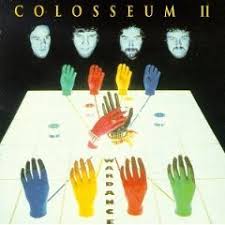

Another step along the pathway to success for Gary, he built much of his varied guitar sound around the three albums he cut with Colosseum II between 1976 and 1978. The sound was more oriented towards jazz/fusion, and two of the albums were almost entirely instrumental. Here he played with Don Airey, who would later go on to play of course with Rainbow, but who would also feature on many of Gary's solo albums, and Neil Murray, who would become famous with Whitesnake and later Black Sabbath, and who would also play on three albums with Gary.
Strange new flesh --- Colosseum II --- 1976 (Bronze)

The first album from the new band, “Strange new flesh” opens on a very psychedelic, seventies progressive rocklike instrumental, called, cleverly, “Dark side of the Moog”, both obviously tailored to tie in with the earlier release of Pink Floyd's seminal “Dark side of the moon” and to pay tribute to the Moog synthesiser, which we have to assume is used by Airey here, and which carries the bulk of the track. There are guitar splashes from Gary, but it's restrained and the piece is mostly keyboard-led. “Down to you” is the first track where we begin to hear what would become Gary's signature guitar sound, a long track at just over nine minutes, it's also the first with vocals.
Mike Starrs is the man who takes them, though after this album both he and Neil Murray would be fired by the label, off the back of disappointing sales. Starrs' vocal is quite rich and full, powerful without being shouty or screamy, and Airey plays some lovely piano on the track. It's all very laidback, a jazzy, easygoing ballad with little of the frenetic rock Gary would later be involved in, and create. “Gemini and Leo” is a lot more uptempo, with some calypso-style beat tinged with a lot of jazz, a bit of blues guitar snuck in by Gary perhaps unnoticed, and on this track you can hear the more powerful side of Starrs' vocal, still very clear and never seeming to have to strain.
There's a pretty solid and boogie-ing bassline too, laid down by Murray, showing the promise in his talent and what he would later go on to achieve, then “Secret places” is the first attempt at real straight-out rock, with a supercool solo from Gary to lead the track in, atmospheric keys from Airey ushering in Starrs' vocal, with clearly audible backing vocals from Gary. Interesting lyric:
”Could you pick yourself out/ From a crowd?/ Would you know what to look for?” Powerful solo then from Mr. Moore takes the song to new levels, and it sounds like he's using the talkbox or some effects pedal on his guitar, unless that sound is being made on the synth? Lovely digital piano takes us into “On second thoughts”, with gentle guitar from Gary, a really nice slow easy ballad, with Starrs back to his soft, soulful best while Airey paints flourishes of synth across the soundscape. A solo the likes of which we would grow used to hearing from Gary in the middle, and a beautiful almost two-minute one to take the song to its gentle but triumphant conclusion. Well, almost. Hiseman's drums kind of kick it up a notch, but I think they could have been used to better effect really, and sort of spoil the ending.
And so we come to the closer, and I have to say, unlike the Skid Row albums, I'm actually enjoying this and it's almost too soon that “Winds”, ten minutes long and so the longest track on the album bursts in on what is essentially a drum solo from Hiseman, joined soon enough though by Gary and then Don Airey and Neil Murray, a lot of energy and enthusiasm in the song. It's more jazz-oriented than rock, with dashes of prog-rock in there as well, another powerful vocal delivery from Mike Starrs, in what would in fact be his last contribution to Colosseum II.
Much of the track develops into an open-ended, improvisational jam, with Gary vying with Don Airey to see who can be the most expressive on their instrument. This level of, as it's often known, technical wankery is probably not needed, but considering how well they mesh it's probably forgivable, and it does all come more or less full circle as the song winds up, leaving you with not an entirely unfavourable ending to an album which for its six tracks is pretty good value for money, and certainly gives us a valuable insight into the burgeoning talent of Gary Moore.
TRACKLISTING
1. Dark side of the Moog
2. Down to you
3. Gemini and Leo
4. Secret places
5. On second thoughts
6. Winds
Electric savage --- Colosseum II --- 1977 (MCA)
Moderator cut: image removed
With Neil Murray and Mike Starrs fired by Bronze, Colosseum II moved labels to MCA, where they remained for this and their third and final album. With no vocalist recruited, it was decided to make the album mostly instrumental, with Gary taking the vocal on the only track that isn't, and new bassist John Mole replacing the departed Murray. Opener “Put it this way” is another jazz rocker, uptempo and with some great guitar from Gary, more excellent keyboard work from Don Airey, then “All skin and bone” is more ethereal, with gongs and shimmering percussion from Hiseman, synth effects from Airey before Gary's guitar comes in, knitting the whole thing together. The piece does seem to be mostly a vehicle for the bandleader's drumming, however.
The lovely ballad “Rivers” proves to be the only non-instrumental track, and as mentioned it's Gary's first chance to take the spotlight as singer, a task he handles with aplomb and obvious talent. Of course, he had already sung on his debut solo album “Grinding stone” by now, so was no stranger to the mike, but this is the first time his voice is heard --- at least as lead vocalist --- within the Colosseum II unit. He polishes the song with his trademark evocative guitar, of course, then we're back to instrumentals with “The scorch”. There are no nine or ten-minuters on this or the next album, and in fact none go over six minutes, this one just edging being the longest track by two seconds. Opening on proggy keyboards from Airey, it's joined by a thumping, heartbeat bassline from Mole, almost like a steam locomotive approaching from the distance. Lots of flying fingers from Airey, but it's about a minute and a half before Gary comes in, his power chords levelling the song.
Keyboard takes over again though, and as “All skin and bone” seemed written for Hiseman's drumming to shine, “The scorch” seems geared towards showing what Don Airey can do on the keys. It's a decent melody, but doesn't feature enough of Gary's playing for my liking. This is soon addressed though when the next track, “Lament”, hits, as it's carried almost entirely on Gary's guitar. Surprisingly, with a title like that, it's not a slow ballad-type song, in fact there are church bells in the distance, lending the song an almost victorious or triumphant air.
“Desperado” then is pure jazz fusion, uptempo and boppy, plenty of guitar but driven mostly by organ from Airey and machinegun drumming from Hiseman. “Am I” slows everything down, in an almost Vangelis-like tune, lots of echoey and jingly keyboards, nice low bass, and some nice smooth guitar from Gary completes the melody. Closer “Intergalactic strut” starts with again a big drum intro, then the keys fly in but this time it's not long before Gary is getting in on the act. Another fast improv jam really to end the album.
I don't know. I liked the first album, and really like Mike Starrs' voice, pity he's gone by the release of this album. An album full of instrumentals, few of them rock? Like I say, I don't know. But then again, these albums are only really being reviewed to fill in blanks, as stepping-stones shown along the path to Gary's career, and you can certainly hear him developing his style here. Good to hear him sing too, if only the once.
TRACKLISTING
1. Put it this way
2. All skin and bone
3. Rivers
4. The scorch
5. Lament
6. Desperado
7. Am I
8. Intergalactic strut
War dance --- Colosseum II --- 1977 (MCA)

Their second album for MCA, and indeed their last, again an almost completely instrumental affair, “War dance” retained the lineup from previous album “Electric savage”, opening with a harder, rockier sound as keyboards and then hard and heavy guitar introduce the opener and title track, appropriately named, as it sounds like a musical call to arms. Even boasting some “bugle-call”-type flurries on Airey's keys, heavy militaristic drumming from Hiseman. Whistling, breezy keyboards and funky bass are the characteristics of the jazzy “Major Kes”, with little if any semblance of rock in the tune, a nice laidback slow and smooth guitar solo in the middle against fluid keyboards, then back into the uptempo jazz. On the previous album we had “Put it this way”, now we have “Put it that way”, again another jazzy bopper riding on squealing keyboards mostly, taking us into the only vocalised track on the album, again voiced by Gary.
The last time round he sang about rivers, this time it's “Castles”, his voice a lot more falsetto than we've been used to, and the song itself is a ballad, but still retaining the jazz elements of the so-far bulk of the album. Nice sparkling keyboards from Don Airey, a comforting bassline from John Mole, and even a certain sense of soul about the song as it progresses. Quite nice really. We're back into the instrumentals then, and “Fighting talk” does indeed come out fighting, with a big guitar intro and then the kind of work we later became used to hearing from the fingers of Gary Moore. A blues boogie rocker, it's (sorry jazz fans!) a welcome break from all the jazz that's been going on up to now, and a great vehicle for the guitar mastery of our Mr. Moore.
“The inquisition” keeps things rocky, and fast, and again we're treated to a guitar extravaganza from Gary, his instrument pretty much taking over the track, which is fine by me! Some great Spanish guitar thrown in for free, too. Better and better! It can't last though (can it?) and things slow right down for the longest track on the album, the penultimate and rather lovely “Star maiden/Mysterioso/Quasar”, very restful, sort of like floating along on music as Don Airey's spacey synth locks with John Mole's deep, throaty bass and carries you along. Gary's guitar then adds its own layer to the sound, and then church bells and wind sounds signify a change in pace and melody, presumably the “Mysterioso” part of the tune, as Gary's guitar gets very rocky and shoulders its way to the front, with some pretty damn fine piano from Mr. Mole too.
Then the church bells and wind take us into the third section, “Quasar”, on speedy keyboard and expressive guitar as the bass picks up speed and rhythm, something akin to tubular bells as the song heads towards its conclusion. Great piece this, really marking a standout for Colosseum II in my book. The appropriately --- and, as it turned out, prophetically --- titled “Last exit” closes the album powerfully on an almost Genesisesque slow rocker, with a virtuoso performance from Gary behind shimmering keys from Airey, making this I believe my favourite of the three albums.
After this Gary would leave to work on his second (some say first) solo album, and go on to play with Thin Lizzy. He would be replaced by Don Airey's brother Keith, but a short time later Don himself would hear the call of Rainbow, effectively bringing about the breakup of Colosseum II. When I started listening to and reviewing their albums today, I really didn't like much of what I was hearing, but as the albums went on they do seem to have got progressively better, and without question they were a fine proving ground for the emerging talent of Gary Moore, and indeed Don Airey.
TRACKLISTING
1. War dance
2. Major Kes
3. Put it that way
4. Castles
5. Fighting talk
6. The inquisition
7. Star maiden/Mysterioso/Quasar
8. Last exit